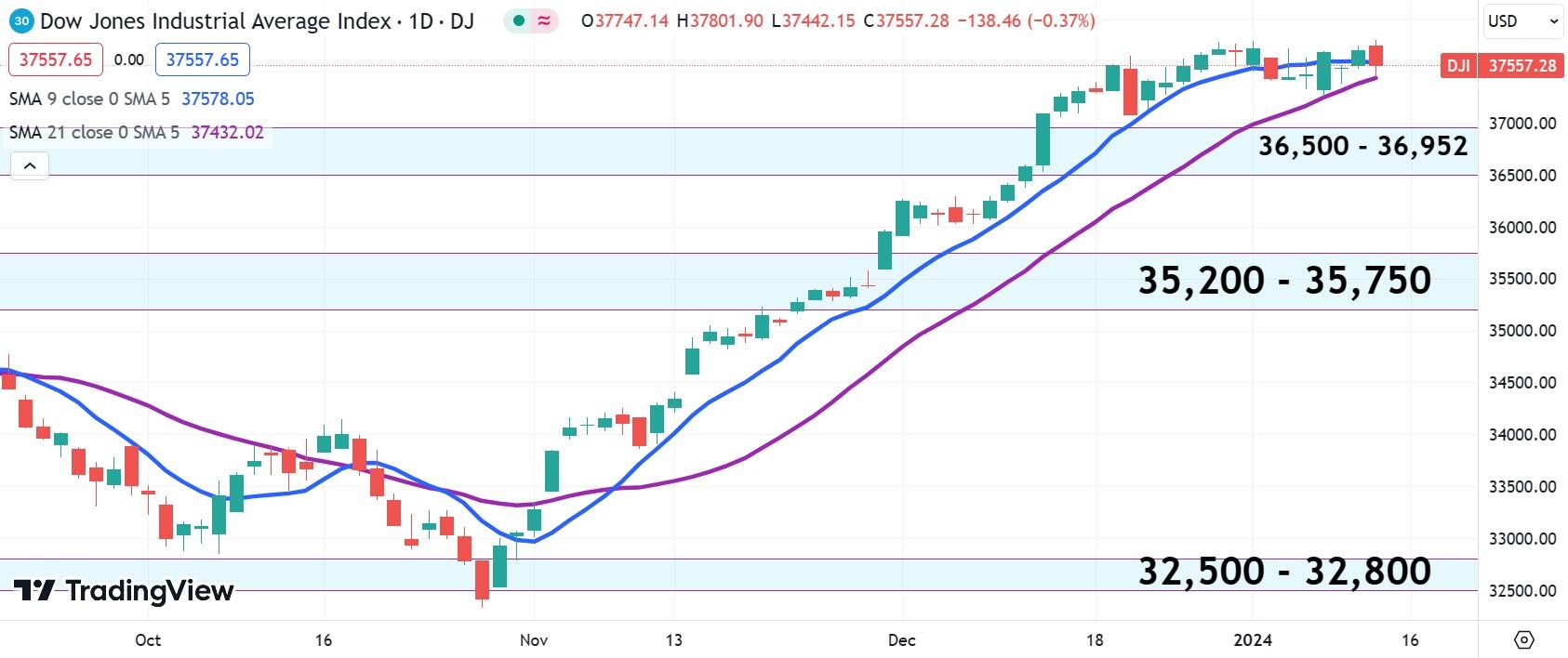- US Treasury yields fall at front end of curve after poor auction results.
- S&P Global Manufacturing and Services PMIs for January surprise to upside.
- Dow Jones Industrial Average awaits Friday’s PCE inflation data to drive direction.
- Visa, Intel and American Express are still on the earnings docket.
The Dow Jones futures market responded affectionately to an early Thursday release on Q4 GDP. The US economy grew 3.3% in the fourth quarter, much better than the 2% print that was expected.
Dow Jones component IBM (IBM) beat earnings and revenue consensus for the quarter ending in December, and the news of it sent the legacy tech firm surging more than 8% late Wednesday. A big earnings miss by Tesla (TSLA) bodes poorly for the NASDAQ Composite index however.
The Dow Jones Industrial Average (DJIA) traded lower for its second day in a row on Wednesday despite rallying higher for much of the session. An afternoon US Treasury auction for 5-year notes disappointed the market as the previous auction for that tenure went off at a yield of 3.801%, but low demand on Wednesday for the $61 billion in government debt meant the auction reached 4.055%. This led the morning’s lower trending yield curve to revert to gains in the afternoon, which dented the equity rally.
The market started out the day optimistically after a survey of the US manufacturing and service sectors outperformed to a great extent, showing that both parts of the US economy are in expansion.
The rest of the week will rely to a great extent on earnings from several Dow Jones components, as well as Friday’s inflation snapshot from the Personal Consumption Expenditures (PCE) report.
Dow Jones News: PMIs get slighted by weak Treasury demand, DJIA to pivot on PCE
The January S&P Global Manufacturing Purchasing Managers Index (PMI) for the US hit a 15-month high of 50.3 early Wednesday. This reading was far above the previous print of 47.9 and demonstrates that the manufacturing sector has rotated toward expansion. Any reading above 50 means the sector is expanding.
The S&P Global Services PMI also hit a seven-month high of 52.9 versus the forecast for a decline from 51.4 to 51.0. While the market has often treated positive US economic news as bad for stocks over the past year, this reading drew applause, and the Dow Jones zoomed higher on the release.
Before the market opens on Friday, the US Bureau of Economic Analysis will release the Core PCE data for December. Similar to the Consumer Price Index (CPI), the PCE conveys a snapshot of the state of inflation in the US economy.
The biggest difference between the CPI and the PCE is that the Fed prefers it to the CPI when deciding to raise or lower interest rates. Consensus calls for annualized December Core PCE to drop from 3.2% to 3%. This would amount to further evidence that the Fed’s high rate environment continues to work toward reducing inflation.
The CPI earlier this month came in hot, and a hotter than expected reading for the PCE will send the S&P 500 into a tailspin. This is because a higher inflation reading will likely influence the central bank toward postponing rate cuts that are currently expected at either the March or May meetings.
Dow Jones earnings: Intel, Visa, American Express
Tuesday was a big day for index components in the Dow Jones. Dow component Johnson & Johnson (JNJ) posted an earnings beat on Tuesday alongside Procter & Gamble (PG), which offered up a mixed quarter but impressed on margins. Verizon Communications (VZ) beat expectations via its wireless segment, while 3M (MMM) beat consensus on adjusted earnings but sold off on worrying guidance.
Thursday sees Visa (V) and Intel (INTC) releasing quarterly results. The charge card leader is expected to post $2.34 in adjusted EPS on $8.55 billion, both of which amount to healthy gains on an annual basis.
Much is expected from Intel’s ongoing turnaround, and this quarter’s consensus has the semiconductor firm earning $0.45 in adjusted EPS on $15.17 billion. These results would be much better than Intel’s results one year ago, and analysts have recently turned optimistic about CEO Pat Gelsinger’s attempt to kindle a renaissance. The company saw a unanimous upward revision in earnings estimates among analysts for Q4.
American Express (AXP) also reports on Friday. The Visa competitor is expected to post adjusted EPS of $2.65 on $15.95 billion in sales, and analysts are equally bullish on its profit prospects relative to Visa.
Dow Jones FAQs
What is the Dow Jones?
The Dow Jones Industrial Average, one of the oldest stock market indices in the world, is compiled of the 30 most traded stocks in the US. The index is price-weighted rather than weighted by capitalization. It is calculated by summing the prices of the constituent stocks and dividing them by a factor, currently 0.152. The index was founded by Charles Dow, who also founded the Wall Street Journal. In later years it has been criticized for not being broadly representative enough because it only tracks 30 conglomerates, unlike broader indices such as the S&P 500.
What factors impact the Dow Jones Industrial Average?
Many different factors drive the Dow Jones Industrial Average (DJIA). The aggregate performance of the component companies revealed in quarterly company earnings reports is the main one. US and global macroeconomic data also contributes as it impacts on investor sentiment. The level of interest rates, set by the Federal Reserve (Fed), also influences the DJIA as it affects the cost of credit, on which many corporations are heavily reliant. Therefore, inflation can be a major driver as well as other metrics which impact the Fed decisions.
What is Dow Theory?
Dow Theory is a method for identifying the primary trend of the stock market developed by Charles Dow. A key step is to compare the direction of the Dow Jones Industrial Average (DJIA) and the Dow Jones Transportation Average (DJTA) and only follow trends where both are moving in the same direction. Volume is a confirmatory criteria. The theory uses elements of peak and trough analysis. Dow’s theory posits three trend phases: accumulation, when smart money starts buying or selling; public participation, when the wider public joins in; and distribution, when the smart money exits.
How can I trade the DJIA?
There are a number of ways to trade the DJIA. One is to use ETFs which allow investors to trade the DJIA as a single security, rather than having to buy shares in all 30 constituent companies. A leading example is the SPDR Dow Jones Industrial Average ETF (DIA). DJIA futures contracts enable traders to speculate on the future value of the index and Options provide the right, but not the obligation, to buy or sell the index at a predetermined price in the future. Mutual funds enable investors to buy a share of a diversified portfolio of DJIA stocks thus providing exposure to the overall index.
Dow Jones Industrial Average forecast
The Dow Jones Industrial Average has consolidated on Tuesday and Wednesday, while the S&P 500 and NASDAQ Composite keep moving higher. This appears due to large cap technology stocks continuing to hold sway compared with value stocks.
This week the DJIA is having difficulty sustaining a rally above 38,000. It will likely take baby steps as investors grow more confident with buying the index near all-time highs. A new all-time high of 38,109 was only just reached on Monday. The former high of 36,952 should still be seen as medium-term support, but in the short term the 30-day Simple Moving Average should reinforce the price action as it did last week.
The only cause for concern is that there is an RSI divergence on the daily chart. This means that the price action for DJIA has seen higher highs between December 20, 2023 and January 22, 2024, while the Relative Strength Index has seen lower highs over that time period. This pattern typically precedes a bearish reversal.
Dow Jones Industrial Average daily chart
Information on these pages contains forward-looking statements that involve risks and uncertainties. Markets and instruments profiled on this page are for informational purposes only and should not in any way come across as a recommendation to buy or sell in these assets. You should do your own thorough research before making any investment decisions. FXStreet does not in any way guarantee that this information is free from mistakes, errors, or material misstatements. It also does not guarantee that this information is of a timely nature. Investing in Open Markets involves a great deal of risk, including the loss of all or a portion of your investment, as well as emotional distress. All risks, losses and costs associated with investing, including total loss of principal, are your responsibility. The views and opinions expressed in this article are those of the authors and do not necessarily reflect the official policy or position of FXStreet nor its advertisers. The author will not be held responsible for information that is found at the end of links posted on this page.
If not otherwise explicitly mentioned in the body of the article, at the time of writing, the author has no position in any stock mentioned in this article and no business relationship with any company mentioned. The author has not received compensation for writing this article, other than from FXStreet.
FXStreet and the author do not provide personalized recommendations. The author makes no representations as to the accuracy, completeness, or suitability of this information. FXStreet and the author will not be liable for any errors, omissions or any losses, injuries or damages arising from this information and its display or use. Errors and omissions excepted.
The author and FXStreet are not registered investment advisors and nothing in this article is intended to be investment advice.
Recommended content
Editors’ Picks

EUR/USD drops below 1.0450 as USD gathers strength
EUR/USD stays on the back foot and trades below 1.0450 on Wednesday. The cautious market stance helps the US Dollar (USD) stay resilient against its rivals and weighs on the pair as markets wait for the Federal Reserve to publish the minutes of the January policy meeting.

Gold climbs to new all-time high near $2,950
Gold retreats slightly from the all-time high it touched at $2,947 but manages to stay above $2,930 on Wednesday. The benchmark 10-year US Treasury bond yield clings to modest gains above 4.55%, limiting XAU/USD's upside.

GBP/USD retreats below 1.2600 despite strong UK inflation data
GBP/USD struggles to hold its ground and trades in the red below 1.2600 on Wednesday. Earlier in the day, the data from the UK showed that the annual CPI inflation climbed to 3% in January from 2.5% in December. Market focus shifts to FOMC Minutes.

Maker Price Forecast: MKR generates highest daily revenue of $10 million
Maker (MKR) price extends its gains by 6%, trading around $1,189 on Wednesday after rallying more than 20% so far this week. Artemis data shows that MKR generated $10 million in revenue on February 10, the new yearly high in daily revenue.

Money market outlook 2025: Trends and dynamics in the Eurozone, US, and UK
We delve into the world of money market funds. Distinct dynamics are at play in the US, eurozone, and UK. In the US, repo rates are more attractive, and bills are expected to appreciate. It's also worth noting that the Fed might cut rates more than anticipated, similar to the UK. In the eurozone, unsecured rates remain elevated.

The Best Brokers of the Year
SPONSORED Explore top-quality choices worldwide and locally. Compare key features like spreads, leverage, and platforms. Find the right broker for your needs, whether trading CFDs, Forex pairs like EUR/USD, or commodities like Gold.
